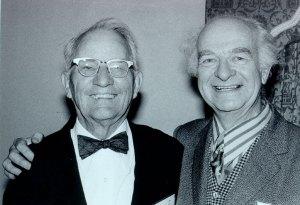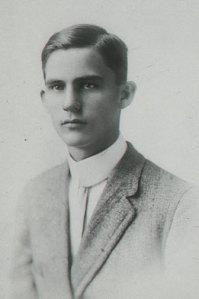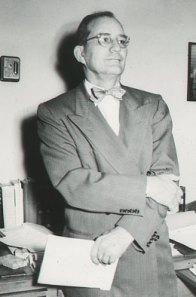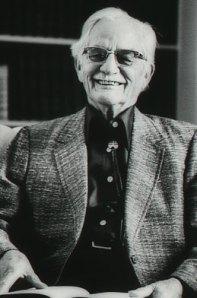
Roger J. Williams and Linus Pauling, 1972.
[Part 1 of 2]
“For about 15 years I have been working in the field of nutrition and I’ve become acquainted with many of the nutritionists, professors of nutrition. I have formed the opinion that Professor Williams is the outstanding man in this field in the world. I think that he has had the better background of training in the basic sciences which has permitted him to attack problems in this field more effectively than any other person.”
-Linus Pauling, November 1979.
Roger John Williams was a prolific scientist in the fields of biochemistry and nutrition who discovered pantothenic acid (vitamin B5) and named and researched folic acid (vitamin B9). He was also an important advocate of public health nutrition. In his writings, Williams emphasized the biochemical diversity of humans and the importance of studying individuals and their different internal environmental requirements through the prism of nutrition. As with Linus Pauling, a large part of Williams’ legacy is one of wide promotion of the importance of nutrition in health and preventative medicine.
Williams was born in Ootacamund, India, to U.S. Baptist missionary parents, on August 14th, 1893. His family returned stateside when he was two years old and he grew up in Kansas and California. He received his bachelor’s degree from the University of Redlands in 1914 and a high school teacher’s certificate from the University of California, Berkeley the following year. His undergraduate experiences with organic chemistry discouraged his initial inclinations toward graduate study in chemistry, and he chose instead to teach chemistry and physics at a local high school. During this time he also married Hazel Wood, his college sweetheart. They later raised three children together and were married for thirty-five years.

Roger Williams, age 16.
After two difficult years of teaching high school, Williams decided at last to pursue graduate school at the University of Chicago, the institution from which all three of his older brothers had graduated. Williams overcame his fear of organic chemistry with the help of a influential professor and earned his M.S. in 1918 and his Ph.D. one year later. His doctoral thesis was titled The Vitamin Requirement of Yeast, scholarship that attracted an unusual amount of attention and that proved to be the basis for much of his later work on nutrition.
Williams departed Chicago to become a professor at the University of Oregon, eventually moving to our own Oregon State University, then known as Oregon State College or OSC. During his two decades in Oregon, he continued to study yeast and human nutritional science, research that promoted the use of microorganisms such as yeast and bacteria in nutritional studies. The use of these substances sped up nutritional experimentation greatly and played an important role in advancing the fields of enzymology, genetics, and molecular biology.
While at OSC in 1933, Williams discovered and isolated pantothenic acid, also known as vitamin B5, an essential vitamin for synthesizing coenzyme-A and synthesizing and metabolizing proteins, carbohydrates, and fats. He later won both the Mead Johnson Award from the American Institute of Nutrition and the Chandler Medal from Columbia University for this discovery.
Not long after, in 1936 Williams’ oldest brother, Robert, synthesized and isolated aneurin (now called thiamin or vitamin B1), an important vitamin for human neurological processes. Roger Williams later discovered that thiamine is also important for yeast growth.

Williams during his graduate school days at the University of Chicago.
Williams and Linus Pauling met at Oregon State College, where Pauling had received his baccalaureate degree in 1922. In 1936 Williams and Pauling began to correspond about Williams’ research on pantothenic acid, Williams requesting Pauling’s help in determining the structure of the substance using x-ray crystallographic techniques. Pauling agreed to help because he was very interested in Williams’ research, and the two continued their correspondence into the following year.
Amidst this scientific collaboration, Williams also wrote to Pauling to complain about the state of the chemistry department at OSC. Pauling, in turn, wrote a letter to the state’s chancellor of higher education, suggesting that the head of the OSC chemistry department, Professor John Fulton, retire and be replaced by Roger Williams. Pauling wrote a glowing recommendation of Williams, noting that
Professor Williams is recognized throughout the country as an outstanding teacher of chemistry and an outstanding research man. His text-books in organic chemistry and biochemistry are widely used and show him to be a thoroughly well trained and able chemist and teacher. His researches and in particular his recent work on pantothenic acid constitute the most important chemical contribution that has been made from Oregon.
Pauling’s interest in the situation did not end with this recommendation. After a visit to Corvallis to give a speech for the Sigma Xi scientific research society, Pauling investigated Fulton by writing a letter of inquiry to Harvard University. He found that Fulton had only finished one course at Harvard, for which he received a C. The rest of his coursework had never been completed. Williams and Pauling thus concluded that Fulton had a phony master’s degree on his vita.
Pauling’s advocacy of Williams apparently fell on deaf ears. In December 1939 Williams wrote to Pauling of a deteriorating environment at OSC and his decision to move on.
I have come to the decision that I must sever my connection with this institution as soon as I can make arrangements to locate elsewhere….The atmosphere in which I have found myself has often not been stimulating and continual annoyances are bound to wear away one’s spirit.
Williams’ departure was Oregon State’s loss; as it turned out, Pauling was correct in his evaluation of Williams’ abilities.
The decision to move having been made, Pauling continued to look out for Williams’ interest, writing query letters to multiple universities recommending the addition of Williams to their departments. In short order, Williams found a position as professor at the University of Texas at Austin. Williams expressed gratitude to Pauling for his assistance in the process and the two made a habit of sharing ideas on possible additions to each other’s departments for many years.

Williams ca. 1950s.
In 1941 Williams founded the Clayton Foundation Biochemical Institute at the University of Texas, serving as its director until 1963. Under Williams’ leadership, more vitamins and their variants were discovered at the Clayton Institute than at any other laboratory in the world. It was during this period that Williams first concentrated and named folic acid, or vitamin B9, an essential vitamin for DNA processes and red blood cell production. Sadly, it was also during this period, in 1952, that Williams’ first wife Hazel died. He married Mabel Phyllis Hobson the next year and the couple traveled extensively together all over the world, remaining happily married until Roger’s death in 1988.
In 1964 the volume of letters exchanged between Williams and Pauling began to increase, because Williams was writing a book and he wanted Pauling’s input. You Are Extraordinary, published in 1967, emphasizes as its central theme the crucial need for scientists to consider people as individuals, rather than focusing on the average human being. Pauling respected this idea so much that he devoted a whole chapter of his own book, Vitamin C and the Common Cold, to Williams’ ideas, extrapolating from them that individuals have unique vitamin C requirements, person to person.

Williams later in life.
In 1970 Williams made news through his publication of an article about an experiment that he conducted on rats in which he fed standard enriched white bread to one group and bread further enriched with trace minerals, vitamins, and protein to a second group. The second group fared much better than the first and he used these results to argue that bread manufacturers in the U.S. should change their enrichment protocols to add more nutrients. In response, corporations in the bread industry stated that they would not make any changes until they were recommended by the Food and Drug Administration.
Interestingly, Williams’ older brother Robert was the scientist who devised the original enrichment recommendations. Enrichment standards are necessary because the typical industrial process of milling white flour in the U.S. removes many of the important nutrients naturally available in grains. Before white bread was enriched, many Americans suffered from B vitamin deficiencies. Roger Williams argued that his brother’s original recommendations were good in 1941, but that thirty years later they could be markedly improved upon.
Williams’ push coincided with problems that Linus Pauling had been facing in his own nutritional research. Both scientists felt that nutrition research was not well respected by medical doctors and most scientists, and thus its importance was downplayed or disregarded. Because of the low degree of institutional esteem afforded to work on nutrition, insufficient funding was available to the field.
Though fighting headwinds on numerous fronts, Roger Williams was well-respected within his own community of researchers. In alignment with Pauling’s ideas related to orthomolecular psychiatry, he served as a founding fellow of the Academy of Orthomolecular Psychiatry in 1971. That same year, Williams became an Emeritus Professor of Chemistry at the University of Texas, though as we’ll see, the vigor of his work did not diminish in retirement.
